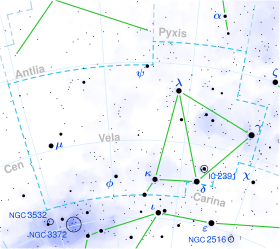HD 74180
| Observation data Epoch J2000 Equinox J2000 | |
|---|---|
| Constellation | Ara |
| Right ascension | 08h 40m 37.57017s[1] |
| Declination | −46° 38′ 55.4770″[1] |
| Apparent magnitude (V) | 3.81[2] |
| Characteristics | |
| Spectral type | F8Ib[3] |
| U−B color index | +0.34[2] |
| B−V color index | +0.71[2] |
| Variable type | suspected α Cyg[4] |
| Astrometry | |
| Radial velocity (Rv) | −25.3[5] km/s |
| Proper motion (μ) | RA: −6.055[1] mas/yr Dec.: 4.66[1] mas/yr |
| Parallax (π) | 0.68 ± 0.16 mas[1] |
| Distance | 990[3] pc |
| Absolute magnitude (MV) | −6.50[3] |
| Details | |
| Mass | 12.63[3] M☉ |
| Luminosity | 38,000[3] L☉ |
| Surface gravity (log g) | 1.38[3] cgs |
| Temperature | 5,750[3] K |
| Metallicity [Fe/H] | 0.56[6] dex |
| Rotational velocity (v sin i) | 21.7[7] km/s |
| Other designations | |
| Database references | |
| SIMBAD | data |
HD 74180 is a binary star in the constellation Vela. It is approximately 3,200 light years from Earth. The primary component is a yellow-white F-type supergiant with a mean apparent magnitude of +3.81, with a 10th magnitude companion 37.5 arcseconds distant.
b Velorum has been classified as a suspected α Cygni variable star which varies by only 0.06 magnitude. There are possible periods near 53, 80, and 160 days, but the variation is largely irregular.[4]
Several studies have considered b Velorum to be a highly luminous supergiant or hypergiant with an early F spectral type, for example F2 Ia+,[4] F0 Ia,[8] and F4 I.[9] There were corresponding luminosity estimates of several hundred thousand L☉. A 2015 study used the Barbier-Chalonge-Divan (BCD) system to derive a luminosity of 38,000 L☉ and a cooler less luminous F8 Ib spectral type.[3]
References
- ^ a b c d e van Leeuwen, Floor (13 August 2007). "Validation of the new Hipparcos reduction". Astronomy & Astrophysics. 474 (2): 653–664. arXiv:0708.1752. Bibcode:2007A&A...474..653V. doi:10.1051/0004-6361:20078357. eISSN 1432-0746. ISSN 0004-6361.
- ^ a b c Ducati, J. R. (2002). "VizieR Online Data Catalog: Catalogue of Stellar Photometry in Johnson's 11-color system". CDS/ADC Collection of Electronic Catalogues. 2237. Bibcode:2002yCat.2237....0D.
- ^ a b c d e f g h Aidelman, Y.; Cidale, L. S.; Zorec, J.; Panei, J. A. (2015). "Open clusters. II. Fundamental parameters of B stars in Collinder 223, Hogg 16, NGC 2645, NGC 3114, and NGC 6025". Astronomy & Astrophysics. 577: A45. Bibcode:2015A&A...577A..45A. doi:10.1051/0004-6361/201425085.
- ^ a b c Van Leeuwen, F.; Van Genderen, A. M.; Zegelaar, I. (1998). "Hipparcos photometry of 24 variable massive stars (α Cygni variables)". Astronomy and Astrophysics Supplement Series. 128: 117–129. Bibcode:1998A&AS..128..117V. doi:10.1051/aas:1998129.
- ^ Wilson, Ralph Elmer (1953). "General catalogue of stellar radial velocities". Washington. Bibcode:1953GCRV..C......0W.
- ^ Luck, R. Earle (2014). "Parameters and Abundances in Luminous Stars". The Astronomical Journal. 147 (6): 137. Bibcode:2014AJ....147..137L. doi:10.1088/0004-6256/147/6/137.
- ^ Ammler-von Eiff, M.; Reiners, A. (2012). "New measurements of rotation and differential rotation in A-F stars: Are there two populations of differentially rotating stars?". Astronomy & Astrophysics. 542: A116. arXiv:1204.2459. Bibcode:2012A&A...542A.116A. doi:10.1051/0004-6361/201118724.
- ^ Humphreys, R. M. (1978). "Studies of luminous stars in nearby galaxies. I. Supergiants and O stars in the Milky Way". Astrophysical Journal. 38: 309. Bibcode:1978ApJS...38..309H. doi:10.1086/190559.
- ^ Mersch, G.; Heck, A. (1980). "Prediction of spectral classification from photometric observations - Application of the UVBY beta photometry and the MK spectra classification. II - General case". Astronomy and Astrophysics. 85: 93. Bibcode:1980A&A....85...93M.

